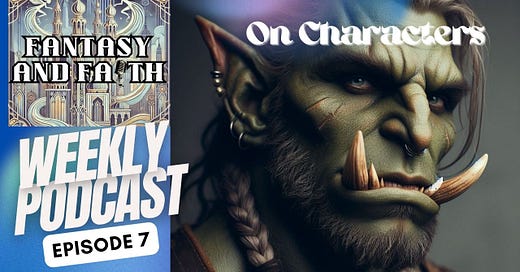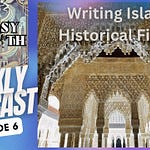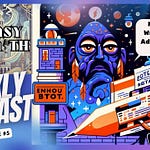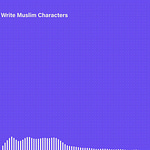Coming up with new characters for a story is one of the most fun and also daunting tasks for any author. Sometimes it comes easily, with a main character already cast in your mind with your initial idea. Other times its like trying to squeeze out that last bit of toothpaste. Let’s start by looking at some of the common characters you get in almost every story.
The Protagonist (Hero, main character)
This is a Greek word that means first actor. The protagonists is your main point-of-view character, or the one the story follows. The job of the protagonist is to learn about their problem and then overcome it. What do the Epic of Gilgamesh, Beowulf and The Odyssey all have in common, other than being early examples of literature? They all feature the protagonist in their title. The protagonist doesn’t have to be larger than life or, even male, but they do have to be active in resolving whatever problem the story has set for them.
The Antagonist (Rival, archenemy, nemesis)
Another word with Greek origins, means the rival. This is the character who’s job is to oppose the protagonist, to ensure they do not resolve their problem, or better yet, have a conflicting problem of their own to solve. Unfortunately, in order for them to solve their problem, they have to make the life of the protagonist miserable.
The Heroine (love interest, hero)
In traditional literature, the heroine was the female love interest of the hero. Her job was to be the damsel in distress or provide a softer side of the protagonist. However, in more recent times, the Heroine has become a protagonist herself. An early example of this is Scheherazade in the A Thousand and One Nights, who is the actual protagonist in the over-arching narrative, using her wits to survive her traumatised husband’s murderous mood swings. More recently we have had Ripley in the Aliens franchise, Lara Croft in the Tomb Raider franchise and of course, Bridget Jones. There is growing trend in the fantasy genre of female leads, with the majority of Romantasy novels fielding lady adventurers saving the world.
The Companion (Best Friend, Side Kick)
Every Gilgamesh needs an Enkidu, every Frodo needs a Samwise Gamgee. The companion is a foil to the protagonist’s more serious and brooding characteristics. They often provide the comic relief, allow the reader to see past the hero’s more business like exterior into their beating heart. For Gilgamesh, Enkidu becomes the cause of his transformation into a more humble and human character. For Frodo, Sam is the shoulder to lean on when things get bad, but also a reminder of what is at stake if he fails to destroy the One Ring. Not every story will have a companion character, or maybe will have more than one to symbolise where the protagonist is in their own character development.
There are also a number of archetypes that reappear in fiction. When we think of Archetypes, normally we are thinking of characters, however, an archetype can also by a situation, idea or object. The reason why they are important is because they symbolise things within our cultures and ambiguous ideas that are hard to define or capture without the use of archetypes. The most common one’s are as follows:
The Warrior: a symbol of courage, strength and power. The warrior is a staple of the fantasy genre. (Aragorn, Harry Potter, Ned Stark)
The Child: symbolises the loss of innocence, coming-of-age, but also wonder. The child is usually innocent and naive but will become changed and world-weary by the adventure. (Grogu, the Hobbits, Arya Stark, Luna Lovegood)
The Orphan: almost all protagonists are orphans in some way. The loss of parents is often the call to adventure in many stories. The Harry Potter books start with the aftermath of his parents’ murder. The Baudelaire children lose their parents in a suspicious fire. Bruce Wayne becomes Batman because of his parents’ murder in Crime Alley.
The Mentor: A wise and world-weary person who ushers the protagonist through the door and gives them the push/advice/weapon that they need to get started on their journey. Gandalf is the obvious one, literally pushing both Bilbo and then Frodo out of Bag End. Obi Wan Kenobi is another example of this, where he presents Luke with a mythical weapon, tells him he needs to join the fight against the Empire, and then shows him the ways of the Force after Luke becomes orphaned.
The Villain: the antagonist and the polar opposite of the hero is a common element in stories too. The Joker in Batman is very much the archetypal villain, going as far as saying that he only exists because there is a Batman. When Batman dies, the Joker becomes depressed, gives up crime and then becomes a version of Batman himself (Batman Who Laughs). Sometimes, there may be more than one villain in the story. The Song of Ice and Fire series is full of villainous characters, and occasionally, people who seemed heroic go on to do villainous things. You don’t have to have a Sauron or Voldemort in the story, sometimes a situation can be the villain, e.g. a world-killing asteroid hurtling towards Earth, a volcano that will destroy the entire city, a virus outbreak that threatens to wipe out human life.
These are just the most common ones. There are plenty of books on literature that have listed over a 100 archetypes.
My Process
Often when I am coming up with a new story, I already have an idea of the who the main characters are. However, they are not fully formed. I need to give them psychological profiles, motivators, likes and dislikes and character arcs. Early on in my development as a writer, I would sketch the character in the margins of my exercise books to give me a visual reference for them. Then later when I was redrafting The Changeling King, I started writing short bios for my characters, listing who their parents are, their friends and love interest. Where did they come from, why are they on the adventure and what will their arc be. Now, I use Obsidian, a free piece of software (
https://obsidian.md/
) that helps me Wiki my characters. I still note down their relationships, but I also write down what their psychological drivers are, what are their motivators, their hopes and fears, as well as what they will become by the end of the journey. The Obsidian software lets me cross-reference my characters and places (which have their own listing) so that I can keep checking back, adding more detail as it develops in my mind and reference in later novels. Often, I will work on the character development just after I have outlined the story. Other times, I start writing and then stop to do some character development and then continue switching between writing and world-building as and when needed.
My Characters
Over the past couple of decades, I’ve written a bunch of characters that have unique and interesting psychologies.
In the Changeling King, there are a number of viewpoint characters, but the main viewpoints are Nathan, Sultan, Karen and Vasch.
Nathan is a teenaged boy from a working class area of a former mill-town in Lancashire. This resonates with me because when I wrote the first draft, I was a working class boy from a Lancashire mill-town too. He lives with his brother (Logan) and his father. The father doesn’t figure in the story but he isn’t a nice man so Nathan and Logan tend to fend for themselves most of the time. Almost all the teenaged characters in this story are missing either one or both parents. This is a reoccurring theme in many stories as it forces young characters to solve problem themselves instead of turning to their parents. It is also makes the characters seem more resilient and allows for their past to hold some mystery to perhaps return to at a later time. For Nathan, it means he is angry all the time because his mother abandoned them at a young age and his father gets abusive when he is drunk. However, he finds some stability with his girlfriend, Salina, who incidentally has an absent father, who went MIA during the second Gulf War. Salina is the balm that Nathan needs to curb his anger and make him feel safe. This safety is important because it means he is able to focus on his ambitions instead of his feelings of abandonment. This manifests in the story through is assumption of the leadership mantle, despite the fact that Logan is older and calmer than him. In Nathan’s mind, Logan is everything that he wants to be. Easy going, liked by everyone and cheerful despite the challenges. Nathan’s arc is to overcome his anger and jealousy of his brother and find acceptance based on his intelligence and loyalty to his friends.
Sultan is from a different time and place than the other teenagers. He is a prince from a small Mughal kingdom, Azamabad, India in 1591AD. He is shown as being compassionate, he saves a tiger cub and raises it by himself, aware of the politics of court life, devoted to his family and spiritual. However, his life is turned upside down when a former ally betrays their kingdom with the help of the East India Company. Sultan is forced to run, chased through the jungle. He manages to find a hiding spot but has to turn to his spiritual training in order to escape detection. Sultan is more the archetypal hero than the other teens, showing positive qualities that would have been common in his time, to contrast with the qualities of today’s teenagers. His goodness is tested when everything he knows is stripped away from him and is driven mad by the trials he faces. His arc involves trying to regain his sanity and gain some measure of control over his situation.
Karen is interesting because she is not a teenager. She is a police detective who saw too many horrific crime scenes in the job whilst she was working homicide in Manchester Met Police. She has moved to work in Western County for a slower pace. She doesn’t have any family or friends around so her only relationships are with her mentor, who also works in the Constabulary and her partner, Detective Hussain. Detective Hussain is a family man and often invites Karen to eat at his house with his wife and kids. When Nathan and his friends go missing at the lake, Karen and Hussain are sent in to investigate. Things start to go wrong when the police station is attacked by Vasch and his trolls.
Vasch is a troll from Kryllon. He is one of the Trollking’s (the main villain) most trusted lieutenants. He has been tasked with travelling to Earth with a squad of trolls to hunt down and kill 5 teenagers who have been foretold to cause the death of the Trollking. Vasch has to lead his band of merry trolls through an alien world, where large metal monsters dominate the skies and stampeded across the land at high speeds. He has to deal with the machinations of a rival in his squad and his own growing disillusionment with the Trollking’s growing insanity. He wants to get his mission done quickly and return home, not realising that he has been sent on a suicide mission.
Alauddin is my current WIP. It is based on the original Arabian Nights story, Aladdin and the Magic Lamp, though it also has familiar elements from the Disney version. I originally wrote this as a teenager, and it was good for what I was capable of then, however, the characters need to be developed more and the story needs a few more beats to make it sing. There are three main characters. Alauddin, Badr-ul-Badour (the Princess) and Jafar.
In the original story, Alauddin is a lazy, good for nothing son, who allegedly makes his father die of heartache because his son won’t do anything. In the Disney version, he is a thief, a street-rat, with a golden heart. I don’t think either of these characterisations are fitting for a hero and role-model for young readers. My Alauddin is a promising student in a house of knowledge in the city of Al-Dhabbiyah, and a dutiful son. He is first seen arguing with a trader over the treatment of his slaves. Alauddin is deeply opposed to slavery due to his mother having been forced into slavery by her landlord in Baghdad, before Alauddin was even born. He meets the Princess one night, outside of his house, but his conduct towards her is both gentlemanly and Islamically correct. Over the course of the story, he comes to admire her loyalty to her people and her fearlessness, but this does not translate into any overtly romantic gestures. He is later tricked by the Wazir, Jafar, to steel the lamp from the Cave of Wonders.
Princess Badr-ul-Badour, which is her original name, is driven by two things. First, Jafar is manipulating her father and has intentions of seizing power, and second, he is trying to force her into marrying him. She escapes the palace one day to try and gain public support against Jafar. However, it is much harder than she realises and ends up cold, tired and hungry in the city at night. She is naïve but she is also clever and uses her wits to solve problems. She is fiercely loyal to her people and her family, but believes that she is the only person that can save both her father’s throne and the city from Jafar.
In the original story, Jafar is actually two separate people, the Grand Wazir and a magician from North Africa. The Disney version merged the two characters into one moustache-twirling, two dimensional villain who wants power for power’s sake. In my story, his powers are limited to illusion and his desire to overthrow the king comes from his family’s history with the royal family. His father was wrongly accused of black magic and ended up dying from an illness in the dungeons. Jafar, having grown up as the king’s playmate, rises up quickly to Grand Wazir when his childhood friend takes the throne. Jafar doesn’t want to openly oppose the king, but uses his superior intelligence and illusions to manipulate the king. He finds the princess attractive, but mainly wants to marry her to gain legitimacy to rule the people of Al-Dhabbiyah, otherwise he knows there is a risk of revolution over-throwing him. However, if he gains the magic lamp he will be able to wish himself onto the throne.
That’s it for this episode. Check out my links in the description. You can support me through Ko-fi. You can also follow me on Bluesky and subscribe to my Substack, Musalmantasy. Don’t forget to like, comment and subscribe for more. Thanks for joining me on Fantasy and Faith. Until the next time, keep dreaming, keep writing, and let your stories shine.














Share this post